|
DIETARY THERAPY OF RENAL FAILURE

|
As can be seen from the table of contents of our Kidney Failure Center, there are many aspects of kidney failure that require attention. The goal of renal therapy, dietary or otherwise, is to prevent extend life expectancy and quality by healing or postponing the toxic state that results when the kidneys do not work as they should. The toxic state in question is called "uremia" and results when the kidneys cannot remove the body's waste products adequately. Diet is an important part of achieving these goals and we are lucky to have commercially available diets made specifically for renal patients.
The idea behind using diet as therapy for kidney disease involves making alterations in the patient's diet to correct or at least dampen the toxic metabolic state of kidney failure. A modified diet can thus be used to correct imbalances and slow progression of disease while maintaining a healthy muscle mass and body condition.
|
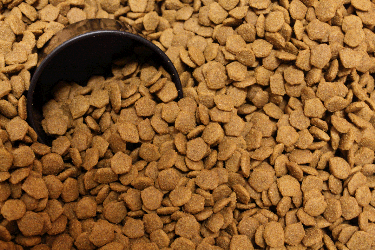 (Photocredit: Anne Hornyak via Wikimedia Commons) (Photocredit: Anne Hornyak via Wikimedia Commons) |
In one famous study where 38 dogs in kidney failure were tracked for 2 years,
dietary therapy reduced the risk of dying by 69%
over dogs allowed to continue eating regular dog food.

Another study in dogs showed that beginning the renal diet
when the creatinine was between 2.0 and 3.1
delayed the onset of uremic crisis by 5 months.

A study of 50 cats with stable naturally occurring renal failure were
divided into two groups, one receiving renal diet and the other receiving regular food.
The cats on the renal diet survived over twice as long as the others.
There are more studies where these came from showing great survival and life quality benefit for renal patients who eat renal diets rather than regular maintenance diets.
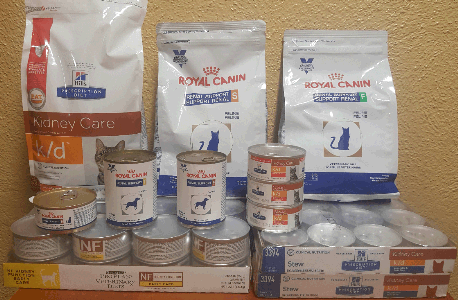
A few of the many renal diets, available from several companies, canned and dry, for dogs and cats.
(original graphic from marvistavet.com)
WHAT MAKES RENAL DIET DIFFERENT?
A renal diet takes into consideration reduction in uremic toxins, control of high blood pressure, calcium/phosphorus balance, maintenance of proper potassium levels and reduction in inflammation. Let's review the features of a renal diet and why they are important:
|
POTASSIUM SUPPLEMENTATION
In chronic kidney disease, potassium is not conserved properly and becomes depleted. When potassium depletion becomes excessive, the patient's overall muscle strength, energy and general life quality are affected. Potassium supplements may be needed in the form of oral gels or powders but ideally, potassium is supplemented in the easiest possible way which generally means incorporating more potassium in the diet. If potassium levels can be maintained simply with food, this would mean less medication for the patient to have to take.
|
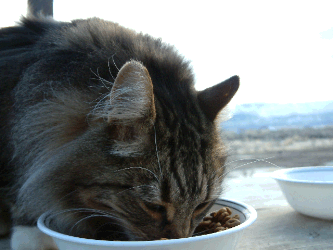 (Photocredit: Morguefile.com) (Photocredit: Morguefile.com) |
PHOSPHORUS RESTRICTION
|
This is a very important part of a renal diet since phosphorus balance is crucial. Phosphorus comes into the body via the diet and leaves the body via the kidney. The problem is that when kidney function is poor, phosphorus is not as well removed as it is supposed to be. Obviously a diet containing less phosphorus gives the kidney less work and helps to keep the blood phosphorus levels normal. When a low phosphate diet is not enough, though, further restriction becomes necessary with addition of medication (i.e. a phosphate binder). Restricting dietary phosphate has been shown to slow the progression of renal disease. For details on goals for the phosphorus level and more details on managing phosphorus click here.
|
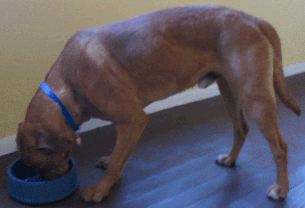 (Photocredit: Morguefile.com) (Photocredit: Morguefile.com) |
If the goal phosphorus level has not been achieved in 4-6 weeks
after starting the renal diet, a phosphorus binder should be utilized.
OMEGA 3 FATTY ACIDS
Studies suggest that kidney failure patients taking omega 3 fatty acids are likely to live longer than patients who do not take them. This has led to the supplementation of most renal diets with fish oils. The full import of fatty acid supplementation is still being worked out.
Other dietary features include B vitamin supplementation (since the damaged kidneys tend to lose excess B complex), non-acidifying features to help control acidosis.
LOW PROTEIN?
|
Since a number of renal toxins come from the break-down and processing of protein, one way to give the kidneys less work to do is to eat less protein. How much less protein depends on how serious the kidney disease is as there is a minimum protein requirement for maintaining body condition and a protein-restricted diet must not be restricted below that level.
Exactly how to restrict protein involves a lot of choices. Older animals tend to require a higher dietary protein level in general when compared to their younger counterparts. Protein also adds palatability to the food so that if we try to restrict protein too much we may end up with a pet who will not eat at all. Further, plant proteins tend to produce less difficulty with phosphorus balance but animal origin proteins may be needed for required amino acids. It is no surprise that decades of research have gone into how protein selection is accomplished to create an effective but tasty diet.
|
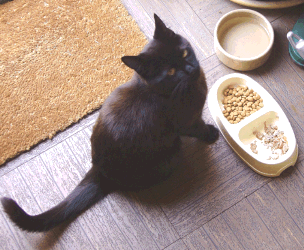 (Photocredit: Public Domain Graphic via Wikimedia Commons) (Photocredit: Public Domain Graphic via Wikimedia Commons) |
- There is no protective value to restricting protein prior to the onset of kidney failure. It is not preventive or at all helpful for a healthy senior pet to be restricted in dietary protein.
- High protein diets do not cause kidney failure (though they certainly make the patient worse after kidney failure is present).
- Protein restriction is probably the least important dietary modification in early stages of kidney disease. There are special diets available for patients with less restrictive needs and other diets for patients in more advanced states.
AT WHAT POINT SHOULD A SPECIAL DIET BE STARTED?
This has been a controversial question for a long time. For many animals changing diet so a less palatable food represents a definite reduction in life quality. There was some thinking that we are changing the diet too soon. On the other hand, if a pet is in a more advanced state of disease before the switch is made, the pet will be much less willing to change to a food of less palatability. The diet companies that make these foods have put a great deal of research into improving palatability over the years which has helped tremendously and, finally, the International Renal Interest Society finally has guidelines.
The IRIS Guidelines recommend considering change to a renal diet by IRIS Stage II (creatinine test between 1.6 mg/ml and 2.8 mg/ml with an SDMA test between 18 & 25 in cats; creatinine test between 1.4 mg/ml and 2.8 mg/ml with SDMA test of 18 & 35 for dogs). The diet should have clear benefit at IRIS stage III which is later on but the recommendation has been moved to a lower stage because animals in stage III are less likely to accept diet change. It was deemed that the change should be made earlier to have a better chance to be in place when it is more crucially needed.
WHAT IF MY PET WILL NOT EAT THE RENAL DIET?
Animals with insufficient kidney function frequently do not feel well and will not be inclined to eat bland food. Here are some tips in increasing acceptance of renal diet:
- Is the pet feeling ill?
As mentioned, the pet that feels ill may be disinclined to eat a new food. Consider using other medical treatments until the pet is feeling better before changing diets.
- Consider feeding access
If the pet feels ill, he or she may not feel like walking across the house to the feeding area. Be sure the food is accessible.
- Offer a choice of renal diets
At this point, there are many renal diets available in different textures and different flavors. There are kibbled foods, stews, morsels and gravy, pates, and loaf formats. Commonly a renal patient will eat one food for a while and then stop accepting it only to accept a new format, even if it was rejected on a prior location. Your vet can help you get a selection so that even a picky pet find something acceptable.
- Appetite stimulants/Medications
Medications such as capromorelin, mirtazapine or cyproheptadine can be used to enhance hunger and encourage eating. If the pet simply does not respond, it may not be possible to use a renal diet and other medications may be needed (as reviewed in other areas of our Kidney Failure Center) to provide therapy.
If the patient is simply too sick to eat at all, assisted feeding may be in order. Please visit our page on Anorexia for more details on dealing with a pet that simply will not eat.
HOME COOKING A RENAL DIET
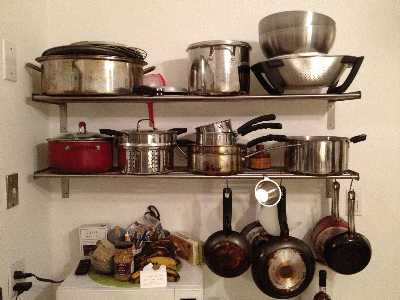
(Photocredit: Morguefile.com)
Home cooking an appropriate renal diet is a complicated task as might be surmised from the information above. Commercial diets have decades of research behind them as well as government regulation and professional quality control. They are also convenient to use. That said, some pet owners prefer to have more control over the ingredients they feed their pets and want more involvement with diet choices. Commercial diets tend to represent a "one size fits all" approach which may not be best.
For renal patients, it is important not to simply try to make up your own diet based on recipes from non-professional sources. Many recipes float around the internet and many pet owners may support them but this is not the same as getting guidance from a nutrition professional such as a member of the American College of Veterinary Nutrition.
Your regular veterinarian can guide you to an appropriate service for nutritional consultation or you may wish to visit the American College of Veterinary Nutrition at www.ACVN.org. Diet is a very important part of therapy for insufficient kidney function and there are many options in flavor, texture, and degree of modification. A pet's preferences may change during the course of the illness as well.
Commercial therapeutic diets are guaranteed, which means that opened packaging and partial cases can be returned for full refund. This will facilitate experimenting with different diets until a well accepted food is discovered.
Other Pages in the Chronic Renal Failure Center:

Posted: 3/22/2011
Last updated: 11/18/2025
|